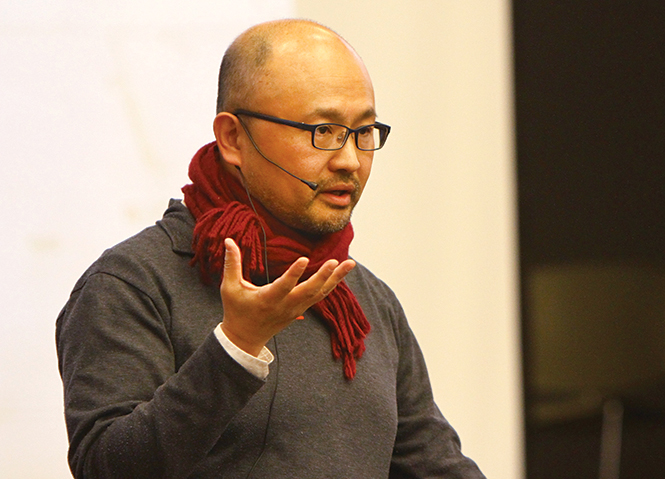Renowned Korean architect visits Kent State
Paul R Csizmadia / Csizmadia Pho
South Korean architect Doojin Hwang answers questions after his lecture entitled “Beyond Modernism: An Asian Perspective”, Thursday, Feb. 27, 2014.
February 27, 2014
Architecture students should gather design inspiration locally while connecting to globally significant concepts, said award-winning Korean architect Doojin Hwang in a presentation Tuesday evening.
“On one hand we need very functional, very efficient lifestyles, and on the other, we want to cling to little things in our lives that tell us we belong to certain groups, which we can relate to,” said Hwang, recipient of the United Nations Educational, Scientific and Cultural Organization Asia-Pacific Cultural Heritage Award.
Hwang’s lecture was the first in the College of Architecture and Environmental Design’s spring 2014 series, Global Geometries. He spoke to a crowd of architecture students that filled the Schwartz Center auditorium.
“His practice has been a process of seeking a new sense of Asian identity by building, researching and reshaping Seoul,” said Ji Young Cho, an assistant CAED professor.
From embracing traditional Korean alleyways to connecting the citizens of Seoul to a previously hard-to-access riverside park through a unique bus stop/elevator structure, Hwang’s career has involved reinterpreting traditional Korean architectural values to work in a modern context.
His most recent work, Castle of Skywalkers, is a training facility for the Hyundai Capital Skywalkers, a professional Korean volleyball team, Hwang said.
“I believe it is the most significant work of architecture I have ever produced,” Hwang said of the building.
Castle of Skywalkers incorporates many different types of geometry in the building’s layers. An atrium containing a volleyball court is at the center of the facility with weight training areas and dormitories on the surrounding levels, Hwang said.
The building is located on a very gently rolling hill, a site unlike any of the surrounding areas of his previous designs, he said.
“It’s almost like designing something in the suburbs of Kent,” Hwang said. “In Korea, that type of opportunity is very hard to come by, especially because I had been working mostly in the old, confined city center.”
Hwang said this new opportunity extracted a very different architect out of himself. Fundamentals, such as sun direction and prevailing winds in the area, became important for him, he said.
“For example, the building is turned around 45 degrees on the cardinal axis,” Hwang said. “By doing this, you can have sunlight on all four sides of the building year-round. It doesn’t create perpetual shadow, which is very good for illumination and warmth.”
Hwang left students with four recommendations: “Work with nature, learn from tradition, be experimental and live our time.”
The next lecture in the College of Architecture and Environmental Design spring lecture series will take place on Wednesday, March 12 at 5 p.m. in the Kent State Student Center Kiva. Yale University professor Keller Easterling will present her lecture on “Extrastatecraft”.
For more information on Doojin Hwang’s architecture, visit djharch.com/.
For more information on the College of Architecture and Environmental Design’s spring lecture series, visit kent.edu/CAED/caed-spring-2014-lecture-series.cfm.
Contact Justin Sheil at [email protected].

























